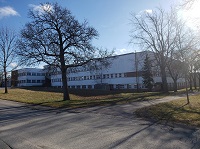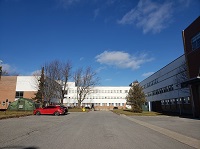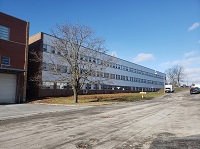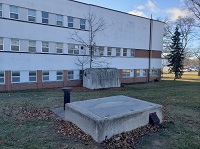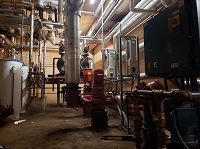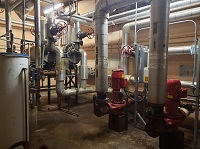Green Heat: Low Carbon Energy Generation for Heating Existing Buildings
Test Drives
The Department of National Defence will put your tech through its paces.
The Green Heat Test Drive is a proof-of-concept project resulting from a Department of National Defence and Canadian Armed Forces (DND/CAF) challenge to acquire, install, and operate a large-scale low-carbon energy generation and storage system for heating an existing building to assess the effectiveness and costs of such a technology. The project aims to prove a business case for modernizing the energy-infrastructure of an existing DND/CAF building and is an integral piece of a Government of Canada-wide mandate focused on carbon emission reduction.
As the project enters its construction phase, preparations are well underway to achieve an environmentally responsible and sustainable way to convert DND’s existing infrastructure. Black & McDonald has already provided a detailed design package to construct the low carbon heating system. Initial construction work includes preparing working drawings and beginning fabrication of the large storage tanks at the contractor facilities.
Results
Results
In September of 2021, DND/CAF, through the IDEaS program, issued a request for proposals (RFP) seeking solutions for the Green Heat challenge. In response to that RFP, IDEaS awarded $477k to Black & McDonald and FVB Energy Inc. to design and engineer a solution.
A building at CFB Kingston (building VC-31) has been selected as the test building for this project, which will:
- maintain the building on the existing electrical power grid, as this project will only modify the heating systems of the building, not the lighting or other electrical demands;
- disconnect the building from the central steam heating plant;
- install a green energy (low carbon emission) heating solution (assisted with on-site solar or wind energy generation);
- install a compatible energy storage system to enable energy delivery even when the generation system is off-line (e.g. due to weather or quantity of daylight);
- maintain a supplemental heating connection to mitigate failures of the new system to provide sufficient heat, to ensure that the building remains operational; and,
- operate the building for approximately two years to determine its effectiveness, costs, and scalability for DND’s real property portfolio.
This project is being conducted in distinct phases:
Concept Development Phase
Completion of a detailed concept to integrate the selected solution into the test building.
Design Phase
Preparation of detailed design documents (drawings and specifications).
Construction Phase
Installation, initial testing and commissioning of the system to ensure the building is ready for occupancy and operational trial of the energy solution.
Operational Phase
Continuing through several seasons of test, data collection and evaluation.
Final Reporting Phase
Detailed report on the results of the technology and recommendations on the scalability and applicability to the wider DND infrastructure footprint.
Challenge
Challenge
The Department of National Defence and the Canadian Armed Forces (DND/CAF) are seeking a large-scale, low carbon energy generation/transfer system for heating existing buildings by integrating with their current hydronic heat distribution systems. A test building has been selected in Kingston, Ontario for a Design-Build team to design and install an innovative system, in order to assess the effectiveness and the costs of these integrated technologies, with the aim of reducing the energy demand and carbon footprint of DND/CAFs infrastructure portfolio. The potential funding for the Design-Build contract component of the project has been established in the range of $5,500,000.
Background
The Government of Canada is committed to reducing its absolute Scope 1 and Scope 2 Green House Gas (GHG) emissions by at least 90% below 2005 levels by 2050. Currently, 60 percent of the energy requirements in DND facilities is for space heating, of which 90 per cent is generated from the burning of fossil fuels. Given that DND has more than 10,000 buildings in its portfolio, the need to address the GHG emissions of these buildings is essential. The challenge is in finding ways to convert these buildings to low carbon heating without requiring a major building retrofit, which would be cost prohibitive.
It is recognized that in addition to how energy is generated/transferred, reducing GHG emissions can also be effected by improving the energy efficiency of a building with such technologies as improved windows or better insulation. With that understood, this research project is focusing only on the energy generation/transfer aspects of the overall issue. The results of this research will enable future large scale decisions where all such additional factors and options will be merged and considered.
Criteria
Criteria
This call is now closed.
The following is a listing of the criteria that was used during the evaluation and selection process. A more detailed description of each was included in the procurement documentation, available through the MERX website.
-
1 - Mandatory Company Requirements
- M1 Industrial Security
- M2 Consent of Surety Letter
-
2 - Technical Pass/Fail Criteria
- PF1 Alignment to the intent of the Green Heat Project
- PF2 Technology Readiness Level (TRL)
- PF3 Human Factors
- PF4 Site Constraints
- PF5 Thermal Demand
- PF6 Performance Monitoring
-
3 - Design-Build Team Pass/Fail Criteria
- DB1 Organization of the Design Build Team
- DB2 Comparable Design Project
- DB3 Comparable Construction Project
- DB4 Key Personnel
- DB5 Schedule
-
4 - Technical Rated Criteria
- TR1 Environmental Impact
- TR2 Thermal Recovery After Cold Soak
- TR3 Scalability
- TR4 Functionality in Different Climate Zones
- TR5 25 Year Life Cycle Cost
- TR6 Potential Technological Improvements
- TR7 Added-Value Features
- TR8 Change Impact to DND/CAF

